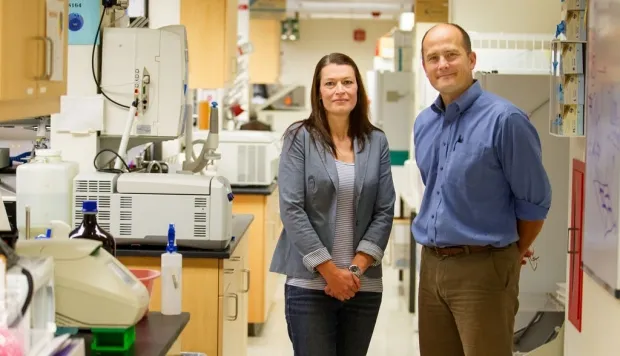A multidisciplinary team of scientists from the American University of Stanford has used a drug in a mouse model to block the production of a substance that accumulates in the pancreas during the pre-symptomatic stage of type 1 diabetes and that is essential for thedisease development.
With the drug, currently used in Europe and Asia to treat pile -related spasms, they managed to prevent damage to insulin producing cells and the appearance of autoimmune disease.The results, described in an article published on Monday in “Journal of Clinical Investigation”, suggest that it may be possible to prevent the appearance of type 1 diabetes in humans if a similar treatment begins before insulin producing cells,or beta cells, are attacked by mistake by immune cells.
The study is the first to relate the progression of type 1 diabetes to changes in the architecture of the extracellular matrix, the network rich in carbohydrates and protein in which the cells that make up the tissues are embedded, according to one of the mainWork authors, Paul Bollyky, professor of infectious diseases.
Most pancreatic cells are dedicated to the manufacture and secretion of digestive enzymes, but the pancreas is also splashed from small groups of hormone -producing cells called islets.A human pancreas contains thousands of islets distributed throughout the organ and a pancreatic islet is formed by various types of cells, each generating a different hormone.Beta cells, for example, produce insulin.
“In type 1 diabetes, only beta cells are destroyed,” says Bollyky.But it is not well known why it happens, only during the first stage of the disease, the pre-symptomatic phase, the pancreatic islets are inflamed, that is, they are infiltrated by immune cells.At first they are at rest, but at some point these cells begin to attack beta cells, finally destroying them enough to effectively eliminate insulin production. ”
“At the moment a person begins to manifest the characteristic symptom of the disease, chronic hyperglycemia, about 90 percent of the beta cells of the pancreas are dead.The cause of the initial infiltration of immune cells in the pancreatic islets or the trigger for its transition of mere passive presence to active aggression is not understood. ”
In a previous study, Bollyky's team measured the levels of dozen substances in the extracellular matrix of human postmortem pancreatic tissue.A substance called hyaluronic acid was too abundant near the beta cells of the pancreas of people with type 1 diabetes, but it was only observed in the pancreatic tissue of patients who had been recently diagnosed, not patients who had lived with the disease for decades.
Hyaluronic acid is usually present in trace concentrations in the extracellular matrix that permeates all tissues, but hyaluronic acid levels are high at the site of an injury."If you twist the ankle or heel, the inflammation that is seen later is due to hyaluronic acid," explains Bollyky.This substance is prone to absorb water, causing the accumulation of liquid in the injured area, a cardinal characteristic of inflammation.
Bollyky points out that the absence of an increase in hyaluronic acid in the pancreatic islets of long -term patients does not mean much, since these people's beta cells had long been defeated.But looking for excessive deposits of hyaluronic acid near pancreatic beta cells in recent casesStart was intriguing for researchers.
The scientists also observed another mouse strain often affected by a version of type 1 diabetes closer to the human form of the disease.But these mice are more difficult to study because only about half of them contract the disease and do it at variable rates.Bollyky explains that in both strains, the hyaluronano accumulated in the pancreatic islets, but not in all of them, only in those where inflammatory immune cells had leverage.There was no excessive hyaluronano deposition in the heart tissue, lung or liver of mice, in line with the idea that the phenomenon occurs only in inflamed tissues.
The accumulation of hyaluronano associated with the islet eventually grew and began to decrease, analogous to the observations of the researchers in the cases of recent -type diabetes of recent appearance against the disease long established in its previous study of human tissue."We asked ourselves what would happen if we prevented accumulation," Bollyky Relata.And we knew a drug that does that. ”
The drug was Hymecromone, or 4-methylumbeliferona (4-mu).Prescribed in European and Asian countries for pain and spasms related to biliary calculation and sold by about 60 companies around the world for research purposes, 4-MU inhibits the synthesis of hyaluronic acid.It is cheap, it can be administered orally and, with more than four decades of use, it has a “very boring security profile”: a very low rate of associated adverse events, says Bollyky.
"It is even approved in Europe for children," says this experts, adding that the FDA has not yet authorized 4-MU for any indication in the United States.In the rodents used in the study, as in people, there is a time window during which immune cells have infiltrated pancreatic islets but most beta cells are still intact.
When the researchers initiated the treatment with 4-MU before most mice cells had been annihilated, none of the mice developed hyperglycemia.The rodents who did not take 4-mu, did suffer from the disease and those who followed a 4-Mu regime, remained without diabetes for at least a year, but if this treatment stopped, they quickly became diabetics.
The tissue analysis revealed the continued presence of immune cells located near beta cells even in mice with 4-mu, but beta cells seemed normal, so immune cells had evidently refrained from attacking them.Scientists have also found reduced levels of hyaluronano in the pancreatic islets of mice treated with 4-MU, indicating that the drug was acting as expected.


